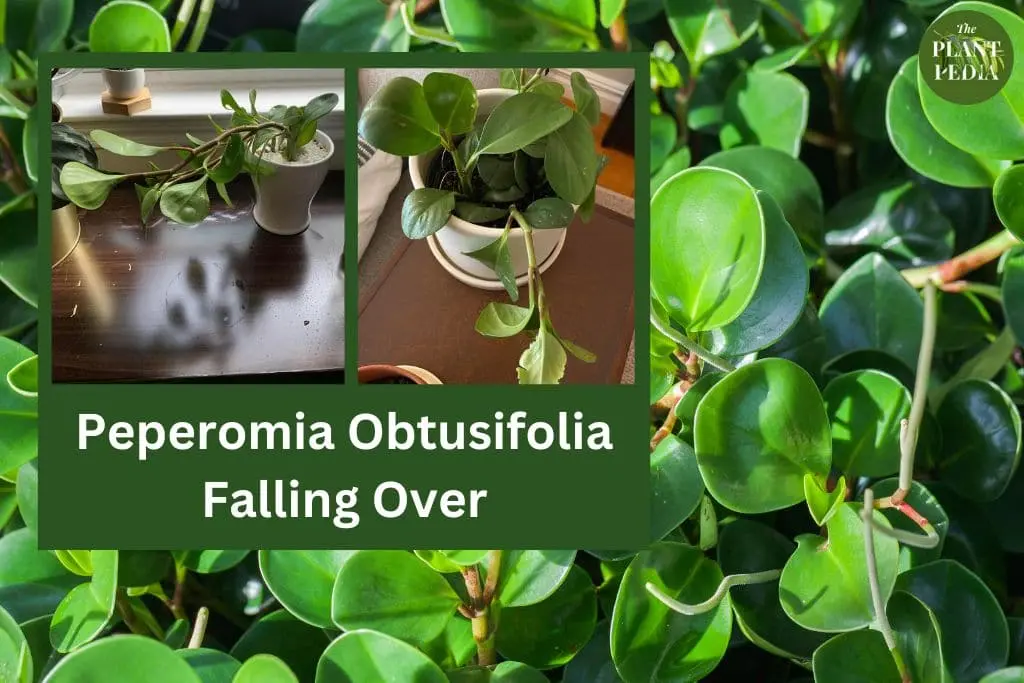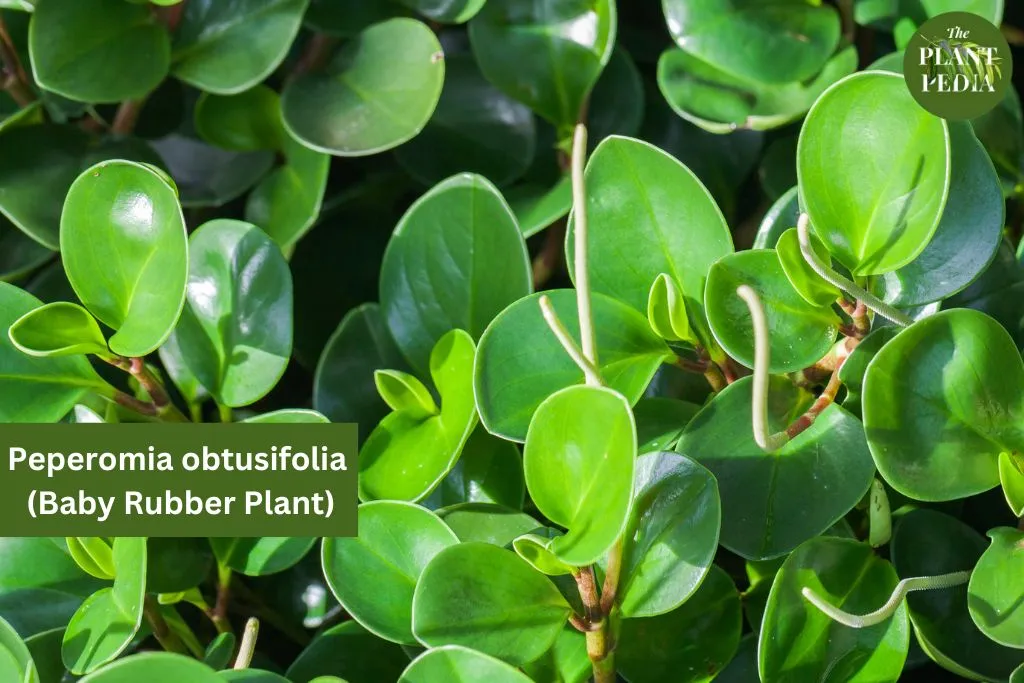Peperomia obtusifolia, commonly known as the baby rubber plant, is a popular indoor plant cherished for its low maintenance requirements and appealing appearance.
However, many plant enthusiasts encounter a common issue with this delightful species: it has a tendency to fall over.
If you’ve ever wondered why your peperomia obtusifolia is leaning or falling over, you’re not alone.
In this comprehensive guide, we will explore the various factors contributing to this problem and provide practical solutions to help you maintain a healthy and upright peperomia obtusifolia.
Understanding the Peperomia Obtusifolia
Before we delve into the reasons behind your peperomia obtusifolia’s falling over, let’s get to know this charming plant a bit better.
Understanding its natural habitat and growth patterns will provide valuable insights into its care requirements.
Background Information
Peperomia obtusifolia is a member of the Piperaceae family, which includes over a thousand species. This particular peperomia is native to Central and South America, where it thrives in tropical rainforests.
In its natural habitat, it typically grows as an epiphyte, attaching itself to trees and rocks, or as a terrestrial plant in well-drained soil.
Characteristics of Peperomia Obtusifolia
- Appearance: The peperomia obtusifolia features glossy, succulent-like leaves that are generally green but may exhibit variegation in some cultivars. These leaves are often described as spoon-shaped or oval.
- Size: This plant is relatively compact, typically reaching a height of 6 to 12 inches, making it ideal for small spaces.
- Growth Pattern: Peperomia obtusifolia is characterized by a bushy growth habit, with stems that can become somewhat woody over time.
Now that we have an understanding of the plant itself, let’s explore the common reasons why your peperomia obtusifolia might be falling over.
Read: Baby Rubber Plant Benefits: Greenery with Perks.

Common Causes of Peperomia Obtusifolia Falling Over
A drooping or leaning peperomia obtusifolia can be attributed to several factors, both intrinsic to the plant and external environmental conditions.
Understanding these causes is crucial in addressing the issue effectively.
Insufficient Light
One of the primary reasons your peperomia obtusifolia may be falling over is inadequate light.
In its natural habitat, this plant receives dappled sunlight, which is essential for its growth and overall health.
Symptoms:
- Leggy growth with elongated stems.
- Leaning or falling over towards the light source.
- Reduced leaf production.
Solution:
To prevent your peperomia obtusifolia from falling over due to insufficient light, ensure it receives bright, indirect sunlight.
Place it near a north or east-facing window where it can enjoy filtered sunlight. If natural light is scarce, consider using a grow light to supplement its illumination needs.
Overwatering or Poor Drainage
Overwatering is a common mistake made by many plant owners, and it can lead to various issues, including root rot, which can cause your peperomia obtusifolia to fall over.
Symptoms:
- Yellowing or browning of lower leaves.
- Soft, mushy stems at the base of the plant.
- A leaning or drooping appearance due to weakened roots.
Solution:
To avoid overwatering, ensure your peperomia obtusifolia is planted in a well-draining potting mix.
Allow the top inch of soil to dry out before watering, and always empty the saucer under the pot to prevent waterlogged roots.
Pot Size and Stability
The choice of pot and its stability can also impact the plant’s ability to stay upright. If your peperomia obtusifolia is in a pot that’s too large or top-heavy, it may have difficulty maintaining an upright position.
Symptoms:
- The plant appears to topple over despite appropriate care.
- The pot feels unstable or tips easily.
Solution:
Choose a pot that is proportionate to the size of your peperomia obtusifolia. A well-balanced pot with a wider base can help provide stability.
Additionally, consider using a heavier potting mix or placing decorative stones or weights in the bottom of the pot to help anchor it.
Aging and Leggy Growth
As your peperomia obtusifolia matures, it can become leggy, with stems that grow longer and may eventually become top-heavy, causing the plant to lean or fall over.
Symptoms:
- Elongated stems with fewer leaves.
- The plant leans or falls over due to the weight of the stems.
Solution:
To combat leggy growth, regularly prune your peperomia obtusifolia. This will encourage bushier growth and help distribute the plant’s weight more evenly. You can propagate the cuttings to create new plants.
Pests and Diseases
Pests and diseases can weaken your peperomia obtusifolia, making it more susceptible to falling over. Common pests that may affect this plant include mealybugs, spider mites, and aphids.
Symptoms:
- Yellowing or curling leaves.
- Visible pests or webbing on the plant.
- Overall decline in plant health.
Solution:
Inspect your plant regularly for signs of pests or disease, and treat any infestations promptly. Use neem oil or insecticidal soap to eliminate common pests.
Ensure good airflow around the plant to deter pest infestations and maintain overall plant health.
How to Care for a Healthy and Upright Peperomia Obtusifolia
Now that we’ve identified the common causes of peperomia obtusifolia falling over, it’s essential to learn how to care for this plant to prevent these issues and promote a healthy, upright growth.
Light Requirements
Provide your peperomia obtusifolia with the appropriate amount of light. As mentioned earlier, it thrives in bright, indirect sunlight.
Ensure that it receives at least 6-8 hours of indirect light daily. Rotate the pot occasionally to promote even growth and prevent the plant from leaning toward the light source.
Watering
Proper watering is crucial to the health of your peperomia obtusifolia. Water the plant thoroughly when the top inch of the soil feels dry to the touch, but avoid letting it sit in standing water.
Always empty the saucer under the pot after watering to prevent root rot.
Pot Selection and Stability
Choose a pot that provides stability to your peperomia obtusifolia. Ensure the pot has drainage holes to prevent water from pooling at the bottom.
If you’re repotting, select a pot that’s only slightly larger than the current one to avoid over-potting.
Pruning and Maintenance
Regularly prune your peperomia obtusifolia to encourage bushier growth and prevent it from becoming leggy.
Use clean, sharp scissors or pruning shears to trim the stems just above a leaf node. You can propagate the cuttings to create new plants, ensuring a continuous supply of healthy specimens.
Pest and Disease Management
Monitor your peperomia obtusifolia for signs of pests or disease and take immediate action if you spot any problems. Isolate affected plants to prevent the issue from spreading to other houseplants.
Consider using natural remedies like neem oil or insecticidal soap to treat common pests.
Supportive Measures
To help your peperomia obtusifolia stay upright, you can use stakes, trellises, or bamboo supports to provide additional support to the stems.
This is especially useful if your plant has grown tall and tends to lean under its weight.
Repotting Peperomia Obtusifolia
As your peperomia obtusifolia grows, it may outgrow its pot, and repotting becomes necessary.
Repotting allows you to refresh the soil, provide more room for growth, and address any stability issues.
When to Repot
Peperomia obtusifolia typically needs repotting every 2-3 years. Signs that it’s time to repot include:
- Roots becoming root-bound and growing out of the drainage holes.
- The plant toppling over due to an unstable pot.
- A noticeable decline in growth or health.
How to Repot
Here’s a step-by-step guide to repotting your peperomia obtusifolia:
Step 1: Choose a new pot that is 1-2 inches larger in diameter than the current one and has drainage holes.
Step 2: Remove the plant from its current pot, gently shaking off excess soil from the roots.
Step 3: Inspect the roots and trim any damaged or excessively long ones.
Step 4: Place a layer of fresh, well-draining potting mix in the bottom of the new pot.
Step 5: Position the plant in the new pot, ensuring it sits at the same depth as in the old pot.
Step 6: Fill in the remaining space with fresh potting mix, pressing it down lightly to secure the plant.
Step 7: Water the plant thoroughly after repotting, allowing excess water to drain away.
Step 8: Keep the plant in a shaded area for a few days to allow it to acclimate to its new environment.
Propagation of Peperomia Obtusifolia
If your peperomia obtusifolia has become leggy and prone to falling over, propagation is an excellent way to rejuvenate the plant and create new specimens.
Here are two common methods for propagating peperomia obtusifolia:
Leaf Cuttings
Leaf cuttings are a straightforward method for propagating peperomia obtusifolia. Follow these steps:
Step 1: Select a healthy leaf from the parent plant.
Step 2: Cut the leaf into sections, making sure each section has a vein running through it.
Step 3: Allow the cuttings to air dry for a day or two, allowing the cut ends to callus.
Step 4: Plant the calloused leaf sections in a well-draining potting mix, burying them about 1 inch deep.
Step 5: Keep the soil consistently moist but not waterlogged.
Step 6: New plants should start to grow from the leaf sections within a few weeks.
Stem Cuttings
Stem cuttings are another effective way to propagate peperomia obtusifolia:
Step 1: Cut a healthy stem section just below a leaf node (the area where a leaf attaches to the stem).
Step 2: Allow the cut end to air dry for a day to form a callus.
Step 3: Plant the calloused stem cutting in a well-draining potting mix, burying it about 1 inch deep.
Step 4: Keep the soil consistently moist but not waterlogged.
Step 5: New growth should emerge from the stem cutting within a few weeks.
Related FAQs:

Why is my Peperomia Obtusifolia falling over?
There can be several reasons for your Peperomia Obtusifolia to fall over. The most common causes include insufficient light, overwatering, pot size and stability, aging and leggy growth, and pests or diseases.
Identifying the specific issue can help you address it effectively.
How can I prevent my Peperomia Obtusifolia from falling over due to leggy growth?
To prevent leggy growth, regularly prune your Peperomia Obtusifolia. Trim the stems just above a leaf node to encourage bushier growth.
You can also propagate the cuttings to create new plants, maintaining a compact and healthy appearance.
Can I use supports to keep my Peperomia Obtusifolia upright?
Yes, you can use stakes, trellises, or bamboo supports to provide additional support to the stems of your Peperomia Obtusifolia.
This is especially useful if your plant has grown tall and tends to lean or fall over under its weight.
How often should I repot my Peperomia Obtusifolia to prevent it from falling over?
Repotting your Peperomia Obtusifolia is typically necessary every 2-3 years or when you notice signs of the plant outgrowing its pot, becoming root-bound, or showing instability.
Choosing a slightly larger pot and refreshing the potting mix can help maintain a healthy and upright plant.
What should I do if my Peperomia Obtusifolia has fallen over completely?
If your Peperomia Obtusifolia has fallen over completely, gently remove it from the pot and inspect the roots for any damage.
Trim any damaged or unhealthy roots and replant the plant in a stable pot with fresh, well-draining soil. Water it thoroughly and provide the necessary care to help it recover.
Can I use fertilizer to help my Peperomia Obtusifolia grow stronger and prevent falling over?
Yes, you can use a balanced, diluted liquid fertilizer during the growing season (spring and summer) to promote healthy growth and prevent legginess.
Be sure to follow the recommended dosage on the fertilizer label and avoid over-fertilizing, as excessive nutrients can harm your plant.
Are there any specific pests or diseases that commonly cause Peperomia Obtusifolia to fall over?
While various pests, such as mealybugs, spider mites, and aphids, can weaken Peperomia Obtusifolia, causing it to decline and potentially fall over, the primary issue is often related to the plant’s care and environment.
Regularly inspect your plant for signs of pests or diseases, and take appropriate measures to address any issues promptly.
Can I use a support pole to help my Peperomia Obtusifolia grow upright?
Yes, you can use a support pole or stake to help your Peperomia Obtusifolia grow upright. Secure the stem to the support pole using soft ties or plant clips, being careful not to damage the stem.
This can be especially helpful for tall or top-heavy plants.
Conclusion
Peperomia obtusifolia is a delightful houseplant that can thrive in your home with the right care and attention.
If your plant is falling over, remember to assess its light, watering, potting, and maintenance needs to address the issue effectively.
With proper care, your peperomia obtusifolia can stay healthy, upright, and a beautiful addition to your indoor plant collection for years to come.
Whether through repotting or propagation, you have the tools and knowledge to ensure your peperomia obtusifolia remains a vibrant and eye-catching part of your living space.
Happy gardening!
